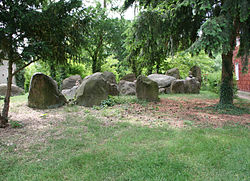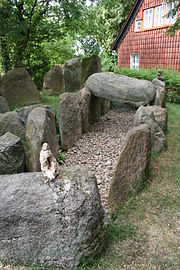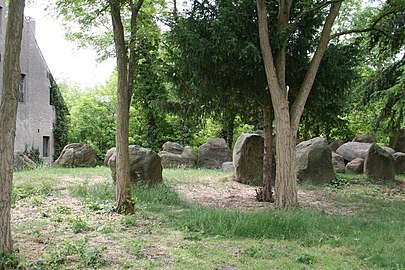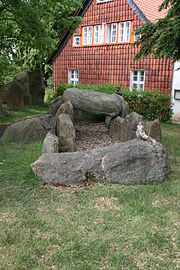Large stone grave Winterfeld
| Large stone grave Winterfeld | ||
|---|---|---|
|
The large stone grave Winterfeld, view from the north |
||
|
|
||
| Coordinates | 52 ° 44 '25.1 " N , 11 ° 14' 40.7" E | |
| place | Apenburg-Winterfeld , Saxony-Anhalt , Germany | |
| Emergence | 3700 to 3350 BC Chr. | |
The large stone grave Winterfeld is a megalithic grave complex of the Neolithic deep engraving ceramic culture in Winterfeld , a district of the municipality of Apenburg-Winterfeld in the Altmarkkreis Salzwedel , Saxony-Anhalt . It is possible that there was originally a second large stone grave near Winterfeld, which was destroyed in the 19th century.
location
The grave is located in the village center of Winterfeld, east of the village church in the adjacent parish garden.
The Lindenberg was north of Winterfeld, near the border with Sallenthin . Another prehistoric grave was located here, which could also have been a Neolithic large stone grave or a Bronze Age burial mound .
Research history
The preserved grave was first described by Johann Friedrich Danneil in 1843 . Several of the enclosure's stones were removed in the 1860s or 1870s (see below). The grave was taken up again in the early 1890s by Eduard Krause and Otto Schoetensack . In 1977 the grave was examined and restored by the State Museum of Prehistory in Halle (Saale) under the direction of Johannes Schneider . A further investigation and restoration took place in 2001. 2003-04 a further recording and measurement of all still existing large stone graves in the Altmark was carried out as a joint project of the State Office for Monument Preservation and Archeology Saxony-Anhalt , the Johann-Friedrich-Danneil-Museum Salzwedel and the association “Young Archaeologists the Altmark ”.
The Lindenberg was archaeologically excavated by Danneil around 1835 and probably destroyed a little later.
description
The large stone grave Winterfeld
The grave belongs to the passage grave type and is oriented northeast-southwest. It was originally on a hill, which today only reaches a maximum of 50 cm. The grave consisted of 14 wall stones and several cap stones (only one of the latter has survived), which enclosed the burial chamber, as well as a trapezoidal enclosure. This is no longer completely preserved today and still consists of 19 stones. Its current length is over 26 m, but is originally estimated at 54 m. The former width was between 5.5 and at least 7.3 m. In the south-west there is still one of the original two “ guard stones ”, which clearly towers over the other surrounding stones. It measures 2.1 × 1.6 × 0.8 m.
The actual burial chamber has a rectangular floor plan and measures 7.4 m in length and 1.6–1.7 m in width. Their height is around 1.6 m. The only remaining capstone measures 2.2 × 1.4 × 0.4 m. The chamber can be reached from the north end of its southeast side via a corridor . This consists of four small wall stones, there is no capstone. The corridor is 0.6–0.8 m wide and 1.0 m high, and its length is 2.3 m. The floor is laid out with three threshold stones 1.3 and 1.0 m apart. The southwest side of the burial chamber forms a single "gable stone". About 30 bowls were incorporated on its surface .
- Large stone grave Winterfeld
The destroyed grave in Lindenberg
The Lindenberg was a round hill with an outer and an inner stone enclosure. During an excavation around 1835, Johann Friedrich Danneil was able to find five human skeletons and several ceramic vessels, but does not mention any megalithic burial chamber. It is therefore unclear whether (as Hans-Jürgen Beier suspected) it was another large stone grave.
The large stone grave Winterfeld in regional legends
An Altmark legend deals with the origin of the grave and connects it with the construction of the church towers in Winterfeld and Jeggeleben . According to legend, the tower in Jeggeleben was built according to plans by masters , but the one in Winterfeld was only built by journeymen . However, since the Winterfeld Tower was ultimately the prettier of the two, the Jeggeleben masters got angry and started a dispute with the journeymen, which eventually ended with both parties trying to throw fieldstones in each other's tower. The masters' projectiles landed right next to the Winterfelder Church and formed the grave. The journeymen chose larger stones that only flew into the Jeggelebener fir trees. However, the large stone graves there have now disappeared.
In 1962 the local history researcher Hermann Künne described the history of the grave's destruction in the 19th century. Even if the story is not an actual legend, it still has fabulous elements. Around 1840, a third of the stones were initially used to construct buildings when small fields were merged into larger ones. A second incident is described in detail, which happened between 1863 and 1873: The son of a large farmer wanted to marry the daughter of a small farmer from the neighboring town of Cheinitz , but his father was against it. The son then asked the pastor to mediate and in return promised him to take care of the construction of his farm buildings. The pastor finally managed to change the father's mind and the son kept his promise. Ten surrounding stones were used for the construction of the farm buildings, including one of the two “guard stones”.
See also
literature
- Hans-Jürgen Beier : The megalithic, submegalithic and pseudomegalithic buildings and the menhirs between the Baltic Sea and the Thuringian Forest (= contributions to the prehistory and early history of Central Europe. Volume 1). Wilkau-Haßlau 1991, p. 59.
- Hartmut Bock , Barbara Fritsch, Lothar Mittag: Great stone graves of the Altmark . State Office for Monument Preservation and Archeology Saxony-Anhalt and State Museum for Prehistory, Halle (Saale) 2006, pp. 167–171.
- Johann Friedrich Danneil : General report on excavations in the vicinity of Salzwedel / von [Johann Friedrich] Danneil zu Salzwedel. In: New communications from the field of historical-antiquarian research. Volume 2, 1836, p. 577 ( online ).
- Johann Friedrich Danneil: Special evidence of the barrows in the Altmark . In: Sixth annual report of the Altmark Association for Patriotic History and Industry . 1843, p. 115 ( PDF; 5.5 MB ).
- Hans-Ulrich Kelch: Mysterious pans. In: Hartmut Bock (Ed.): Cities - Villages - Friedhöfe. Archeology in the Altmark 2: From the High Middle Ages to the modern age (= contributions to the cultural history of the Altmark and its peripheral areas, Volume 8). Oschersleben 2002, ISBN 3-935358-36-9 , pp. 458-469.
- Eduard Krause , Otto Schoetensack : The megalithic graves (stone chamber graves) of Germany. I. Altmark . In: Journal of Ethnology . Vol. 25, 1893, p. 160 / no. 174, plate VI / 174 ( PDF; 39.0 MB ).
- Teachers' Association of the Altmark (ed.): Altmärkischer Sagenschatz. Leipzig / Berlin 1908, p. 150.
- Lothar Mittag: barrows, special stones and stone crosses in the legendary world of Altmark . Johann-Friedrich-Danneil-Museum Salzwedel, Salzwedel 2005, pp. 28–30.
- Britta Schulze-Thulin : Large stone graves and menhirs. Saxony-Anhalt • Thuringia • Saxony . Mitteldeutscher Verlag, Halle (Saale) 2007, ISBN 978-3-89812-428-7 , pp. 36-37.
- U. Vogt: The large stone grave in Winterfeld. Unpublished manuscript, Berlin 2001.
Web links
- The Megalithic Portal: Winterfeld Stone Grave
- grosssteingraeber.de: The large stone grave Winterfeld near Salzwedel
- tw.strahl.org: Large stone grave "Winterfeld", Winterfeld, Altmark
- www.museen-altmarkkreis.de
Individual evidence
- ↑ Hartmut Bock, Barbara Fritsch, Lothar Mittag: Großsteingraves der Altmark. 2006, p. 11.
- ↑ Hartmut Bock, Barbara Fritsch, Lothar Mittag: Großsteingraves der Altmark. 2006, pp. 167-168.
- ↑ Hans-Jürgen Beier: The megalithic, submegalithic and pseudomegalithic buildings as well as the menhirs between the Baltic Sea and the Thuringian Forest. 1991, p. 59.
- ↑ Hartmut Bock, Barbara Fritsch, Lothar Mittag: Großsteingraves der Altmark. 2006, pp. 168-169; Mittag, pp. 28-29.
- ↑ Hartmut Bock, Barbara Fritsch, Lothar Mittag: Großsteingraves der Altmark. 2006, pp. 169-170; Noon, pp. 29–30.






